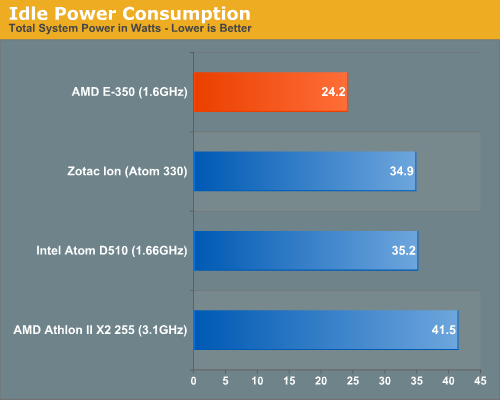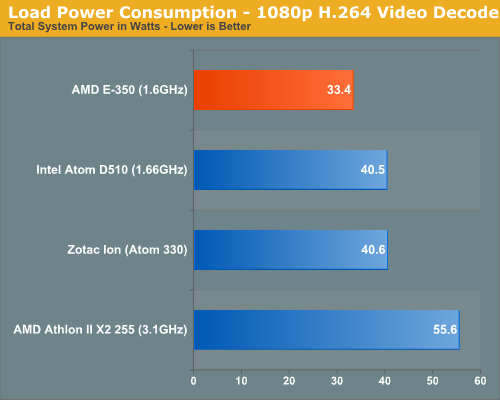The Brazos Review: AMD's E-350 Supplants ION for mini-ITX
by Anand Lal Shimpi on January 27, 2011 6:08 PM ESTPower Consumption: Better than Atom
Power efficiency was a big draw of Atom, but does AMD sacrifice any of that in order to deliver the performance it does with the E-350? To be blunt: no, not at all.
I don’t have any pico PSUs or anything super efficient readily available so don’t expect any of the numbers to be particularly impressive, but what they are is comparable to one another. I hooked up each one of the systems I’d been using to the same PSU and measured power in three conditions: idle, full CPU load (Cinebench 11.5) and while playing a 1080p H.264 video.

Pine Trail and the old ION platform consume just about the same amount of power at idle. The Athlon II system obviously draws more, in this case an increase of 17%. The E-350 uses less than 70% of the power of the Atom D510 system at idle.

Under load the Brazos advantage shrinks a bit but it’s still much lower power than Atom. While playing a H.264 you’re looking at ~83% of the power of an ION system, and 85% under full CPU load.

Say what you will about Intel’s manufacturing process advantage, it’s simply not put to use here with Atom. AMD’s E-350 is higher performing and uses less power than Intel’s 45nm Atom D510. Did I mention it’s built on a smaller die as well?
I wanted to isolate the CP...err APU and look at its power draw exclusively. I ran the same three tests but this time I’m not measuring power at the wall, but rather just power over the ATX12V connector directly to the CPU.
At idle the E-350 APU only requires around 3W of power. That’s actually not as low as I’d expect, especially given that Sandy Bridge is typically down at 4W when fully idle. AMD is apparently not being too aggressive with stopping clocks and gating when fully idle, at least on the desktop Brazos parts.
| Power Consumption Comparison | |||||
| ATX12V Power Draw | Idle | 1080p H.264 Decode | Cinebench 11.5 | ||
| AMD E-350 | 3W | 8W | 9W | ||
| AMD Athlon II X2 255 | 7W | 12W | 47W | ||
Under load, either full CPU or when using the video decode engine, APU power consumption is around 8 - 9W. By comparison, an Athlon II X2 255 will use 12W when decoding video (this doesn’t include the UVD engine in the 890GX doing most of the heavy lifting. The more interesting comparison is what happens when the CPU cores are fully loaded. The E-350 uses 9W running Cinebench 11.5 compared to 47W by the Athlon II X2.










176 Comments
View All Comments
djfourmoney - Thursday, January 27, 2011 - link
You can build a sub-$350 HTPC with this! If you can recycle some parts from any of your other builds you might be able to get it under $300. I built a ASRock based HTPC based on the price expected for that board ($110) and it comes in at $319 before taxes and shipping. Careful shopping might avoid that.Run Mediabrowser with TV and GameTime! Plug-ins.
You can now throw away your Cable Box SD or HD. If you have standard cable, turning in your box and building a HTPC around one of these boards will pay for itself in about a year.
If you get HD and Premium Channels, hopefully SiliconDust's 3 Tuner CableCard adapter will be out before NFL Training Camp.
For Direct TV/Dish Network/AT&T U-verse, you'll be able to use Hauppauge Colossus with Component Input, eliminate issues with the HD-DVR USB version. As long as they don't cripple the component output, there's no PQ difference.
Khato - Thursday, January 27, 2011 - link
I've been somewhat disappointed with the lack of actual investigation into how changes in memory bandwidth affect this new generation of integrated GPUs - both on Brazos here as well as Sandybridge earlier. The direct comparison to a 5450 here is interesting, but since it wasn't stated I'm guessing those were stock 5450 numbers, not a 5450 underclocked to be the same frequency core/memory?The primary reason for it being a point of interest is that the current rumor has Llano at anywhere from 4x to 6x the shader resources, but only 2.4x the potential memory bandwidth. More likely 2x in any actual systems though given that anything above DDR3 1333 carries a decent premium. So if Brazos is already seeing hints of memory bandwidth limitations...
Anand Lal Shimpi - Thursday, January 27, 2011 - link
Those were stock 5450 numbers, and you are correct - memory bandwidth is an issue (one of Sandy Bridge's "tricks" is the shared L3 cache, it helps mask memory bandwidth limitations quite well as it is currently used for Z operations among other things). I expect that Llano will be much quicker than the E-350, remember that in many cases we're not necessarily GPU bound but rather CPU bound in these game tests.I will continue to play with performance on Brazos but I expect that once I've got Llano in house I'll be able to get a better idea of how bad the memory bandwidth limitations actually are.
Take care,
Anand
Khato - Friday, January 28, 2011 - link
Thanks for the reply. The CPU vs GPU bound comment actually sparked another point of curiosity - how does the performance picture change as resolution increases?There are quite a few games where the performance increase going from integrated to either the 5450 or 5570 is basically the same, implying that it's CPU limited and something about the integrated graphics decreases the performance. The unknown being whether that something is a constant, a slight latency hit due to whatever arbitration scheme is used between CPU and graphics for example, or if it will scale with the load placed upon the GPU, as would be the case for memory bandwidth.
This certainly has me looking forward to at last getting to see how Llano graphics performance is in a few months. I'd find it all too amusing if the better integration in Sandybridge resulted in graphics performance on par with a memory constrained Llano.
bjacobson - Saturday, January 29, 2011 - link
I was thoroughly surprised the e350 coped as well as the dedicated cards using shared RAM.Was not expecting that.
Speed3mon - Thursday, January 27, 2011 - link
this comment... kinda gay.. sry but trueAloonatic - Friday, January 28, 2011 - link
I don't think that even the staunchest homophobe would even go as far as to associate being gay with the nonsense that the OP wrote.It'[ a shame that there isn't a store that fanboys have to shop in, where their beloved companies can rip them off royally, as that seems to be their want.
His comment wasn't gay, it was just sad, and ill-conceived, which might be how their parents probably view them too, in hindsight :o)
etudiant - Thursday, January 27, 2011 - link
The Zacate die size is comparatively minute at 75mm2, about a quarter the size of the Thuban.That translates to perhaps one twentieth of the manufacturing cost, given yields are much better for smaller die. Should be very helpful for AMD if they can deliver in quantity.
GeorgeH - Thursday, January 27, 2011 - link
I'm very impressed. Does anyone have an idea when Intel and VIA might respond with updated products?Anand Lal Shimpi - Thursday, January 27, 2011 - link
Intel's 32nm Atom refresh will appear in Q4 2011.Take care,
Anand